Below the hook: CoGnitive developments
16 February 2021
Modular design spreader beam and specialist engineering company Modulift reports that, since the start of 2020, orders for custom-designed lifting solutions have increased substantially, with no sign of demand slowing. “In September we achieved our highest revenue growth since 2016,” says Sarah Spivey, Modulift managing director. “Our team of engineers and our factory specialists have been designing and building a large number of complex custom lifting solutions. Many of them have been designed, manufactured and delivered in less than a month, including the initial detailed discussion to fully understand the lifting requirements. This is made possible as our sales, engineering and manufacturing departments are now under one roof, since we moved to our new state-of-the-art manufacturing facility last summer.”
Adjustable solutions
“Our custom design solutions are being used across the whole spectrum of the lifting industry for a wide variety of complex lifts,” adds Harshal Kulkarni, engineering manager at Modulift. “We have also seen an increased amount of lifts requiring a low height frame solution requiring adjustability biaxially and performing as multifunctional lifting tools in lifting and spreader configurations… We have found that custom designed products can often be the best solution for lifts like these. We have also been engaged in customising our standard products to suit customer requirements in the most cost-effective manner, too.”
 A 19 x 3 metre custom-designed beam from specialist engineering company Modulift
A 19 x 3 metre custom-designed beam from specialist engineering company Modulift
Adjustability is also at the heart of the Adjustable Modular Lifting Frame (ADLF160) from heavy lifting and transport specialist Mammoet. According to Mammoet, it makes fast adjustment of rigging possible, enabling the installation of multiple modules per day. The frame is 33 metres long and up to 14 adjustable lifting points. It is four metres wide and this can be extended to 7 metres, in increments of 150 mm.
A centre of gravity compensation system means the frame can be adjusted in both longitudinal and transversal directions. This, Mammoet says, increases its versatility, making it usable in a wider range than conventional rigging. The frame can be transported in a 40-foot open-top container. A video of the Adjustable Modular Lifting Frame can be seen here: www.shorturl.at/xJLQS.
 Mammoet’s Adjustable Modular Lifting Frame
Mammoet’s Adjustable Modular Lifting Frame
Mammoet has also partnered with Verton Australia to introduce Verton’s load control equipment to its network of clients. Mammoet believes that Verton’s lifting spreader bars have the potential to help increase safety and raise safety standards in crane operations around the world.
“Verton lifting spreader bars are fully equipped to remotely orientate any suitable load using angular momentum stored in our revolutionary gyroscopic modules to precisely rotate loads in either direction,” explains Trevor Bourne, Verton managing director. “This completely removes the need for taglines or for anyone to be near the landing area of loads, making jobs safer, faster and smarter. When an international heavy lifting authority such as Mammoet embraces new safer lifting devices in this way, it shows great trust and understanding of the technology and the importance to reinvent lifting operations.”
“At Mammoet, our first priority is to ensure that all of our colleagues come home safe each day,” adds Joery van Vlierden, global SHE-Q director at Mammoet. “We constantly seek innovations that will enhance the safety of our operations, and so are happy to use Verton’s load spreading solutions as part of future crane lifting projects.”
Responding to variations in the centre of gravity is a key ability of the SyncHoist system from Wisconsin, USA-headquartered manufacturer Enerpac. The SyncHoist is an hydraulically operated below the hook manoeuvring system for large or unbalanced loads. It comprises four, double-acting, push-pull cylinders connected to lifting points. The cylinders can be suspended directly on ropes or under an auxiliary frame from a crane. They are computer-controlled and allow a crane to accurately hoist and position a load, especially where space is limited.
Accuracy for fusion
Enerpac’s SyncHoist is being used on a high profile job at ITER, the world’s largest fusion experiment, in Southern France. According to Enerpac, millimetre lifting accuracy is required to lift vacuum vessel sectors weighing 500 tonnes into an up-ending tool for vessel assembly by the ITER Sector Sub-Assembly Tool.
The vacuum vessel comprises nine sectors made of special grade stainless steel. Each sector is 13 metres high, 6.5 metres wide and 6.3 metres deep.
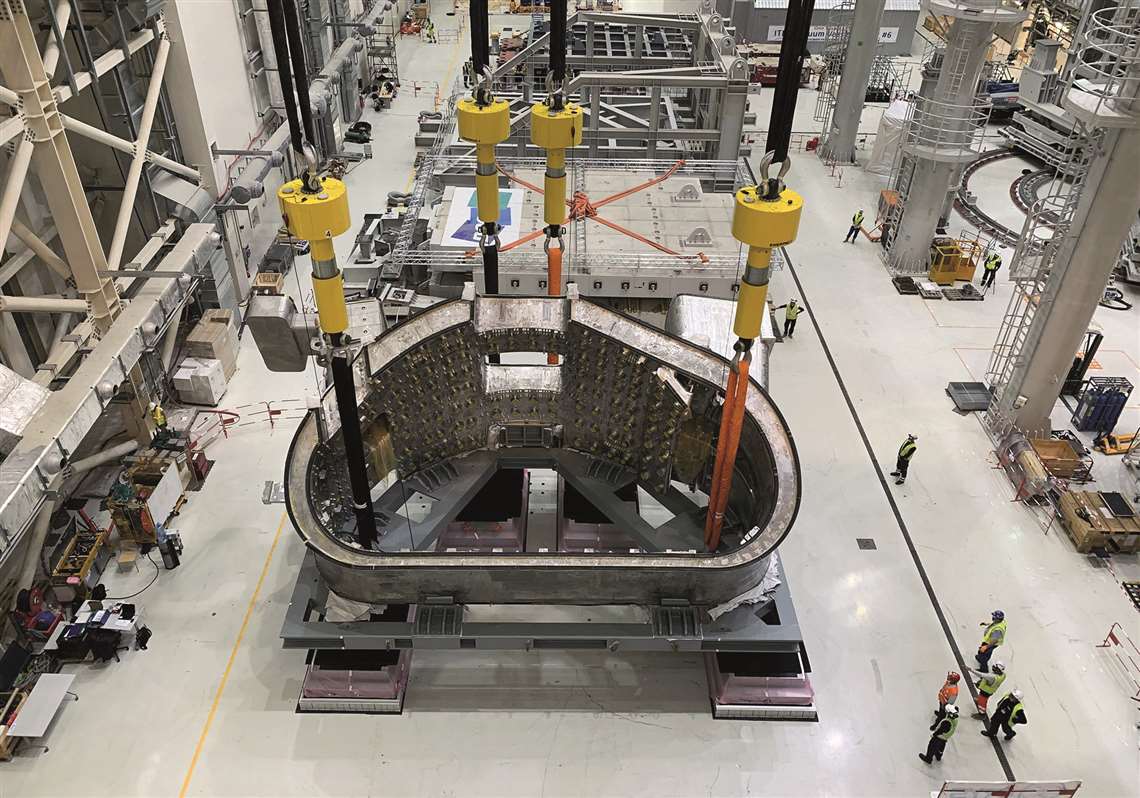 Enerpac SyncHoists working at ITER
Enerpac SyncHoists working at ITER
A SyncHoist is connected to four lifting points on a platform for each vacuum vessel sector. “It is essential that we hold the vacuum vessel sector in the plane during lifting. SyncHoist allows us to know the load at each lifting point and control the lift precisely with a 1 mm accuracy,” explains Jarl Buskop, assembly engineer, Sector Modules Delivery & Assembly Division, ITER. “Another benefit of using SyncHoist to cope with variations in the centre of gravity is the ability to lift the vacuum vessel sector clear of its surrounding transportation frame where there is only 15 to 30 mm clearance for the rigging platform.”
 The SyncHoist enabled the lift to be controlled precisely with a 1 mm accuracy
The SyncHoist enabled the lift to be controlled precisely with a 1 mm accuracy
To meet the ITER project requirements, each 1000 mm stroke SyncHoist hydraulic lifting systems was made leakproof. In addition to the vacuum vessel sectors, the SyncHoist lifting system will be used to lift toroidal magnet field coils for insertion in the vacuum vessel.
In the range
The Enerpac SyncHoist range includes lifting cylinders with 100 and 204 tonne (110 and 225 ton) lifting capacities, plunger strokes of 1 and 1.5 metres and have a high precision lifting accuracy of +/- 1 mm over the full stroke. A single operator controls and oversees the entire hoisting job, using a portable wireless control unit for remote control of all cylinders.
In addition to synchronous lifting and lowering, the operator is able to lift and lower each cylinder independently for balancing, tilting and positioning loads. For repetitive hoisting tasks, the controller can also be pre-programmed for positioning, tilting and aligning of loads. The wireless controller allows the operator to work at a safe distance. No cables are needed, so there is no risk of entanglement or tripping hazards.
Auto-levelling technology is a key feature of Illinois, USA-based The Caldwell Group’s new custom lifting beam for applications where a crane cannot be positioned over a load due to limited travel or obstructions.
The overhang lifting beam has a counterweight that can move or be fixed; movement is powered or manual – although Caldwell recommends using a powered trolley if several lifts a day are required.
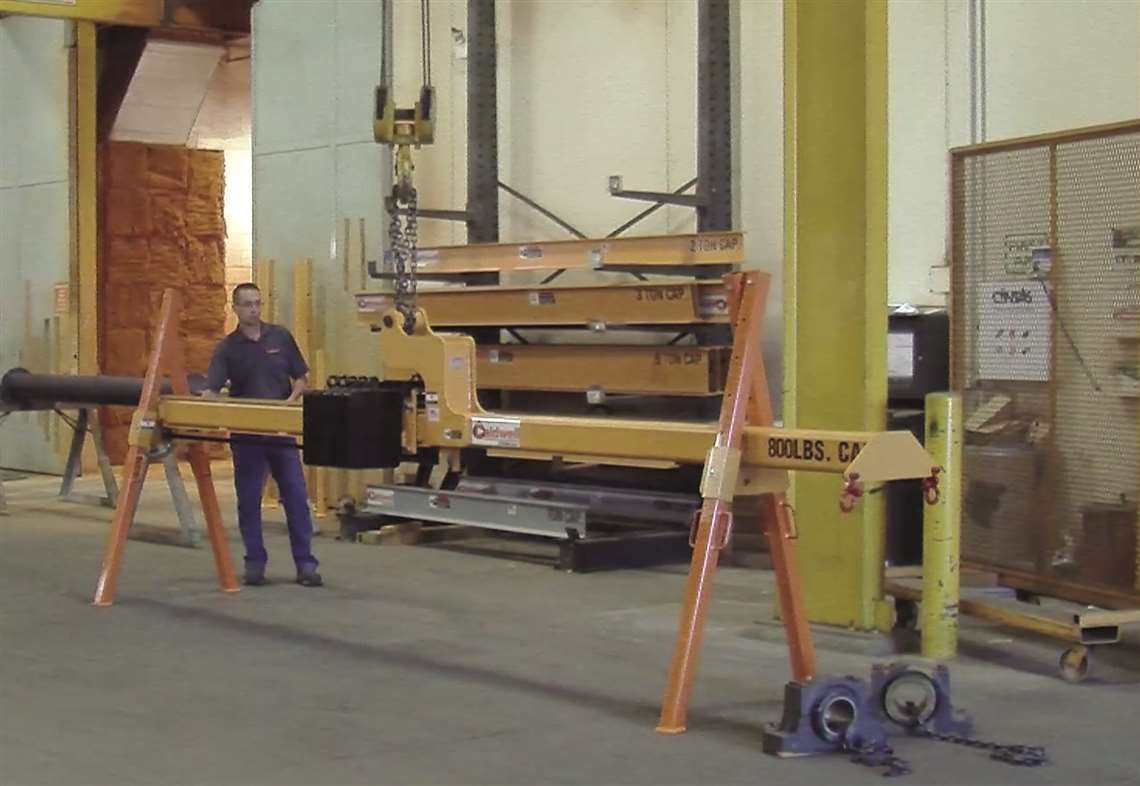 The Caldwell Group’s new custom lifting beam
The Caldwell Group’s new custom lifting beam
“There are a multitude of applications, such as lifting components during equipment maintenance; placing a load onto, say, the third floor of a building in a construction environment; or lifting a partial width roll of material where a monorail crane is centred for full rolls,” says Dan Mongan, senior sales engineer at Caldwell. “We anticipate finding other uses for the beam once word spreads.”
Each system is made for a specific application. The largest has been 4.5 tonnes capacity. Customers can request the auto-leveller feature, taken from Caldwell’s Posi-Turner, designed to rotate bulky and awkward objects.
The auto-leveller version senses when a load is out of level, informs the control system and energises the motor to move the trolley, enabling the operator to focus on crane operation. The auto-leveller can be turned off if required.
On balance
Another centre of gravity tool is the new Insight software from force measurement equipment specialist Crosby|Straightpoint. It allows users to monitor up to 126 load cells from up to 700 metres away, before and during a lift.
Crosby|Straightpoint claims the Insight system is revolutionary and can be used as an all-round load monitoring product, specialising in four main areas: multi-channel display and data logging; load visualisation; proof load testing; and centre of gravity. Included is an SW-D USB wireless dongle so that the product can be used with a laptop, tablet, or other device using Windows.
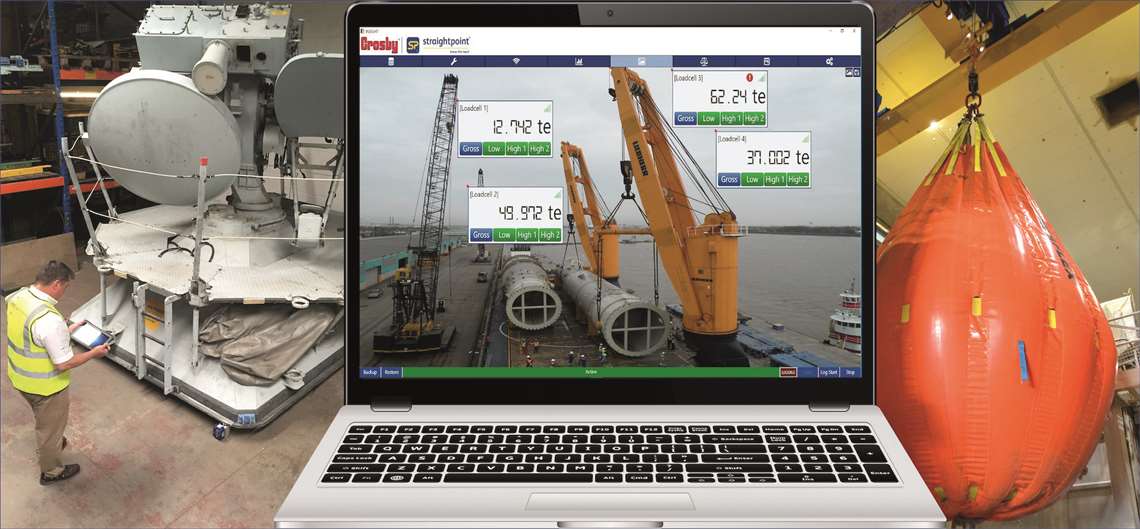 Crosby|Straightpoint’s Insight system
Crosby|Straightpoint’s Insight system
Using the multi-channel display and data logging mode, users can view and log load data from connected individual and multiple load cells, live on screen and directly into a .csv file for later analysis at speeds of up to 200Hz. The visualisation mode is designed for more complicated lifts. It allows a photo of the lift to be imported in addition to drag and drop load cell displays, making the screen look like the lift. Proof load testing capability allows real-time graphing of load tests and auto-generates test certificates. Finally, Insight can be used to weigh and calculate the centre of gravity for large items.
Considering how fast technology has permeated all aspects of our lives, it is little surprise automation is becoming prevalent in all aspects of lifting, including the below the hook sector. Yet, as we all know, every lift is unique so customisation will always be required. The examples above suggest the future will be where customisation and automation not only co-exist in harmony but complement each other.
|
Elebia goes bigger 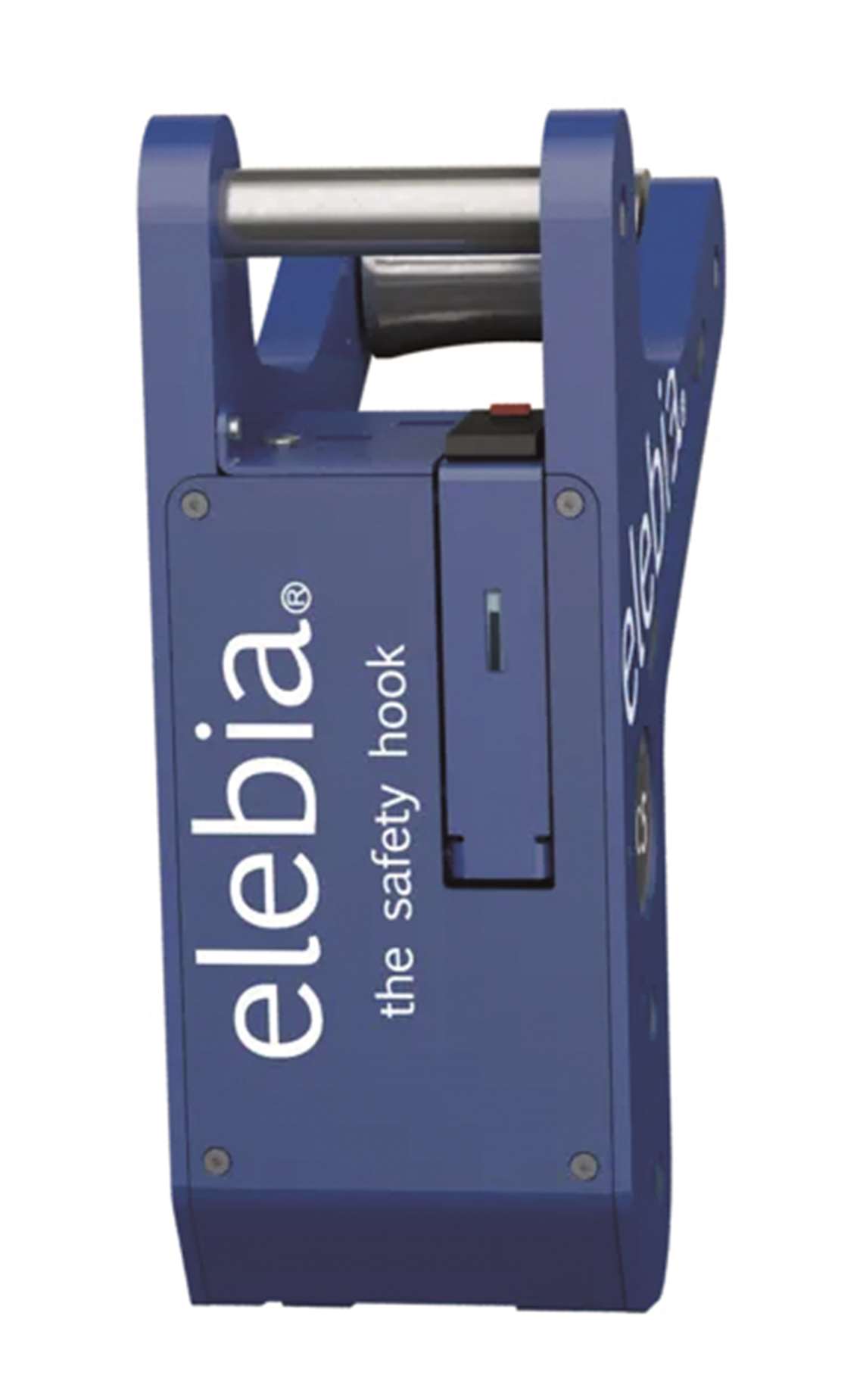 The C6 has a load capacity of six tonnes The C6 has a load capacity of six tonnes
Spanish crane hook manufacturer Elebia has extended the lifting capacity of its Automatic Lifting Clamps with the addition of the C6. It extends the clamp’s maximum lifting capacity from five tonnes to six with a 3:1 safety factor. Automatic horizontal lifting clamps have been designed for lifting and transferring steel plates, beams and pipes in a secure and safe manner. Once the automatic clamps are fixed to the load that is being lifted, the automated process takes over. The crane driver/operator ensures by using the eMax remote control that the lifting clamps are all in the same position before every lift. This information is relayed in real time and should there be any difference in the clamp’s states, the remote control informs the crane operator immediately. Once all clamps are confirmed ready, the lifting operation can commence. An LED indicates the Lifting Clamp’s status. The C5 can be seen in action here: www.shorturl.at/bvGQ9 |
|
Remote control tooling 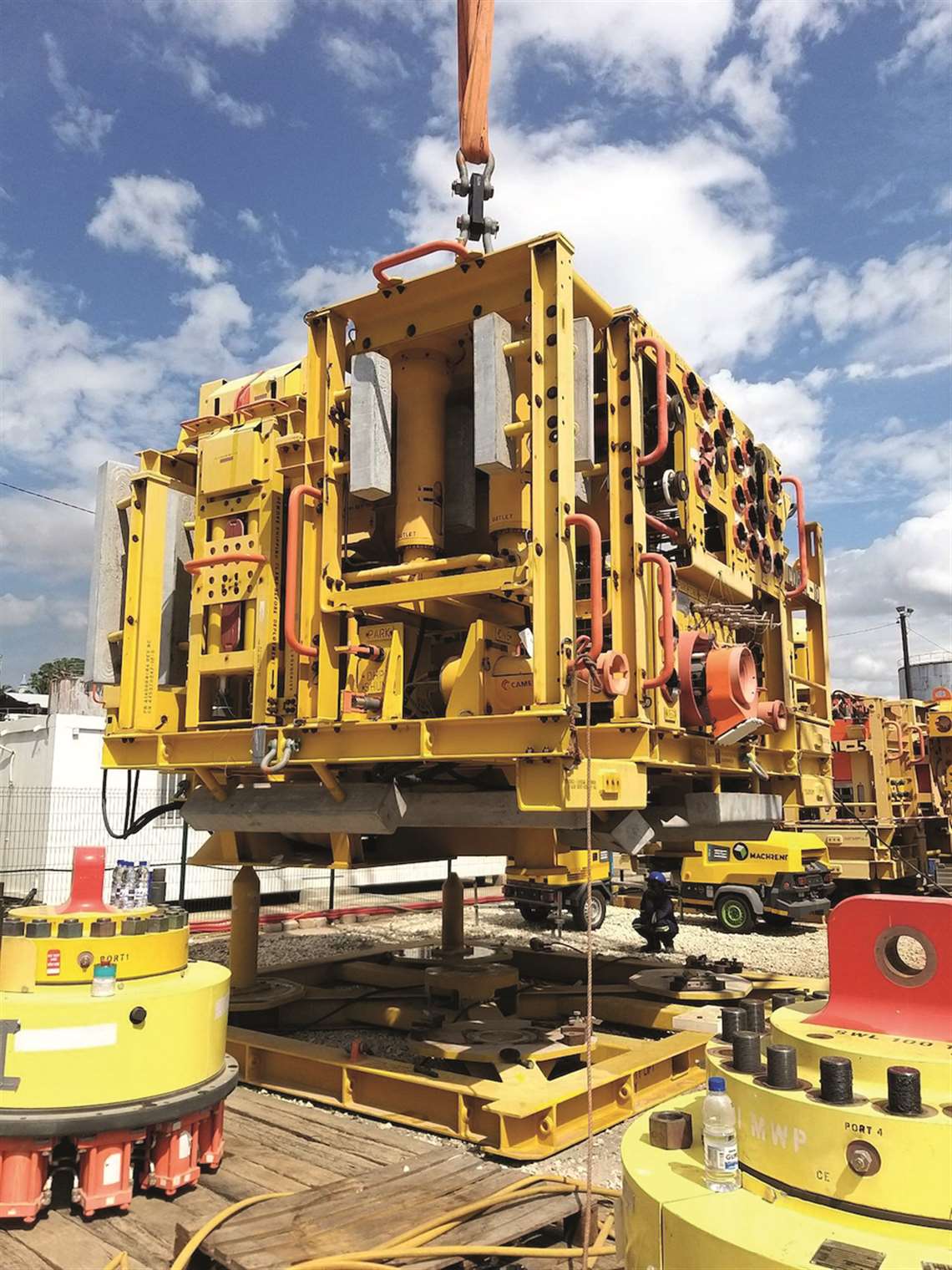
Belgium-headquartered global heavy lift and transportation specialist Sarens used various items of below the hook rigging gear to monitor the weight of seven 85 tonne Christmas trees (an assembly of valves, spools and fittings used to regulate the flow of pipes in an oil well) for an oil and gas company. The equipment included chains, slings and shackles, sourced from Sarens’ local stock, plus a 100 tonne capacity Radiolink Plus load cell from UK-based load monitoring manufacturer Straightpoint, part of Texas-based lifting, rigging, and material handling hardware company The Crosby Group. Sarens also used a Straightpoint 1,000 metre range SW-HHP handheld reading device. “Speed and efficiency of service is paramount to delivery of our services,” explains Julio Paco, lifting operations supervisor at Sarens. “Knowing the weight of items as they follow their supply chain to the point of use is a necessary component of that work. With the Radiolink Plus we were able to take readings at a safe distance using the [handheld] device.” |






